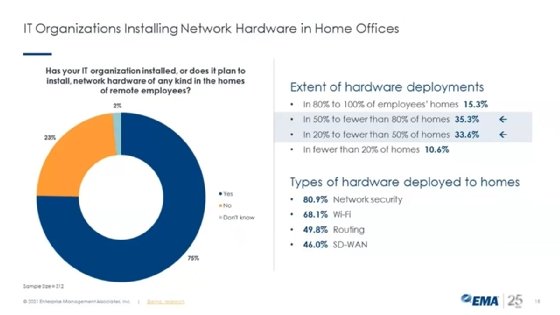
stock.adobe.com
Enterprises look to formalize WFH network architecture
As work-from-home programs prove they're here to stay, enterprise network teams are assessing their network designs to ensure adequate support and performance for home offices.
Enterprises are revamping their networks to better support employees working from home.
Despite worries about budget constraints and infrastructure complexity, enterprise network teams are making moves to formalize WFH network architecture, according to a survey conducted by Enterprise Management Associates (EMA) and released in July. In the survey of 312 IT pros in North America and Europe, 90.7% of respondents said they hoped to deliver home office UX that is comparable to working on premises.
One popular approach teams are taking is to deploy a device to each remote worker -- referred to as a branch of one -- to provide various networking and security functions, such as an access point and security gateway. Respondents indicated they would prioritize network security hardware for WFH networks, followed by Wi-Fi, routing and software-defined WAN (SD-WAN). Many organizations are also reimbursing employees for internet and wireless WAN upgrades, such as LTE, 4G and 5G, for primary or backup connections.
While the upfront costs of these network upgrades could deter some enterprises, the potential tradeoffs of poor employee performance and decreased customer satisfaction pose more of a long-term threat.
"A lot of companies are trying to figure out who needs this and who doesn't and what their budget is going to be," said Shamus McGillicuddy, vice president of research at EMA. The upgrades might be expensive at first, but many organizations are also saving money with changes to real estate and office leasing, further supplementing network upgrade costs, he added.
A tiered approach to WFH support
Most enterprises aren't planning to deploy network hardware at every employee home office, McGillicuddy said. Instead, network teams are identifying groups of users who need better experience and more comprehensive support, such as call center agents, engineers, R&D and C-suite executives.
"Anyone who is customer-facing needs reliable performance and better security for privacy reasons," he said. "People who are using sensitive data at home need to be protected."
For those employees, network teams customize packages depending on roles and job functions. They might send small SD-WAN gateways for reliable WFH connections to some employees and pay others to install fixed mobile connectivity.
But 42% of surveyed organizations said they're taking an undifferentiated approach to how they support remote workers. In those cases, network teams define a set of requirements -- such as network hardware deployments to the home offices or upgrades to software-defined perimeter -- and implement it for all workers, regardless of position.

Network spending is back up
While enterprises stalled their IT and network spending because of pandemic fluctuations, they are now increasing planned spending through 2023, McGillicuddy said. A notable chunk of those planned investments is in LAN and Wi-Fi infrastructure. BYOD programs have grown, he said, and companies need to support those devices with more bandwidth, compliance and security.
Other budget priorities are NetOps and monitoring tools. Prior to the WFH surge, enterprises focused their monitoring on a certain number of devices in their corporate sites. Now, they glean data from multiple home offices, all of which spew out different types of telemetry data. And, while remote desktop access is a critical part of the troubleshooting tool set, it's hard to scale out for multiple employees, McGillicuddy said.
To deal with this data adequately, 95.5% of IT organizations said they were allocating their budgets to enhance NetOps tools for WFH. Tools like endpoint monitoring -- traditionally not part of the networking tool set -- are now needed to pinpoint UX issues, he said. As a result, collaboration is growing between NetOps and SecOps teams, as they recognize the need to share tools and insights. Meanwhile, teams are extending their traditional network infrastructure monitoring to home offices that have hardware deployments.
What about SASE?
While Secure Access Service Edge (SASE) is a newcomer in the networking industry, it gained traction during the pandemic. According to McGillicuddy, 81% of enterprises said they accelerated their engagement with SASE during the months of lockdown to address WFH needs.
In many cases, WFH has blurred the lines between SD-WAN and SASE, as many networking and security vendors have pivoted to deliver a platform with zero-trust network access, SD-WAN and cloud-delivered security, he said.
"A lot of the SD-WAN vendors [enterprises] are working with have accelerated their SASE roadmaps or identified specific use cases, like the expanded work-from-home wave, which meant they were less focused on connecting sites and more focused on connecting people," McGillicuddy said.








